“Home and Rest”
A Ballet Lover’s Guide to Monte Carlo
Back in 2019 I was invited to write for Les Ballets de Monte-Carlo’s Melbourne tour. It proved a fascinating assignment, so much so that I found myself buying early postcards of Monaco. They quickly became my time-traveller’s ticket to imagining myself strolling seaside terraces with the elegantly well-dressed of yesteryear.
Now really, who today would make an opera house part of a casino? And where now could you walk from a splendid hotel to an ornate theatre to a cafe in the style of an Orientalist fantasy, without the inconvenience of crossing traffic-jammed roads?
So here ’tis, specially for those of you in lockdown: a brief tour through Monte Carlo’s glamorous past and dance connections, for the vicarious tourist c.1910-1930 …
Built across a rocky promontory, overlooking the azure waters of the Mediterranean, Monte Carlo has a well-earned reputation as a playground for dancers. By the 1930s, the resort already meant “home and rest” for generations of dancers as ballet author Arnold Haskell recollected.1 For Serge Grigoriev, the regisseur of Diaghilev’s famed Ballets Russes, the locality was the place of practical conveniences embellished by seaside air and restorative sunshine.2 Set close to the French-Italian border, Monte Carlo was the ideal rendezvous for the dancers of various European nationalities who formed Diaghilev’s ostensibly ‘Russian’ company. Equipped with its sumptuous, well-appointed opera house, which Grigoriev remembered “made our work there very pleasant”, Monte Carlo was a neighbourhood that dancers departed “with regret”.3
Today, Les Ballets de Monte-Carlo is the latest – and most stable – dance company to enjoy a fruitful association with the tiny principality of Monaco, continuing a connection that began in the 19th century, when the rugged coastline beneath the cliffs of Monte Agel was first transformed into a fashionable mecca for foreign pleasure-seekers. The story of ballet in Monte Carlo is as fabulous, in its way, as the epic histories of dance in Paris or St Petersburg, a tale of A-list celebrities and extraordinary artistry, interwoven with the fluctuating fortunes of Monaco’s House of Grimaldi. It’s the stuff of fortuitous royal marriages and intrepid impresarios, sweet champagnes and, occasionally, bad plumbing. And always, in the background, there’s the click and whirr of roulette wheels and the shuffle of cards on green baize. Ballet in Monte Carlo begins, of course, with the Casino.
In 1861, Prince Charles III and his mother Princess Caroline faced financial ruin as they looked out over their newly independent nation.4 Monaco’s population, reduced in size by France’s annexation of territories, was too small to sustain taxation, and a gaming concession, introduced at the Princess’s suggestion, was failing dismally to generate revenue. 5 The miserable casino, shabbily furnished and difficult to reach over bad roads, urgently needed vision. It came with Francois Blanc, a manager and financier with experience, deep pockets and a gambler’s heart to match. With an eye to the arrival of the railway, Blanc bought out the struggling concessionaires and embarked on a trnsformation, aided by his clever wife Marie.6 Together they envisaged a resort of immersive comforts: stylish gaming halls, gardens, seaside terraces, luxury accommodation, and every variety of elegant entertainment.
Across the square from the casino, construction began forthwith on the Hotel de Paris, which was furnished “with the taste of an intelligent millionaire” under Marie’s supervision.7 Inside the casino, spaces were enlarged for hosting “balls, concerts [and] fetes”, which were authorised under the terms of the gaming concession.8 In 1878 workmen rallied to build the Casino’s crowning glory: an opera house by architect Charles Garnier, modelled on his recently-completed opera house in Paris. Finished in an astonishing eight-and-a-half months, the new theatre impressed with its intimacy and gilded ornamentation. Only one thing intermittently detracted from its splendour. “For many weeks the most appalling odours have prevailed throughout the Casino,” reported the British medical journal, The Lancet, in 1887, “especially in the reading-room and in the theatre.”9 Visitor numbers exploded; the casino’s sewering took some years to catch up.
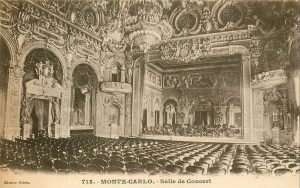
Madame Blanc was worried that the theatre’s opulence – its profusion of gilded ornamentation, friezes, garlands and frescoes – would only remind casino patrons of the money they had lost!
Bad smells aside, the venue’s schedule of free concerts and performances quickly developed Monte Carlo’s cultural reputation, and ballet also gained a foothold after the Romanian impresario Raoul Gunsbourg, was appointed director of the opera house in 1892.10 A former employee of the Russian imperial court, Gunsbourg enticed several leading ballerinas to Monaco including the feted Italian dancer Virginia Zucchi, a friend of Gunsbourg’s from their St Petersburg days, and the Paris Opera Ballet’s reigning star, Rosita Mauri.11 During February 1895, four exclusive performances were also given by the Russian ballerinas Mathilde Kschessinska and Olga Preobrajenska, who travelled with the Grand Duke Michael Nikolaevich and added to the throng of wealthy, cosmopolitan Russians, who descended on the Riviera each winter. The American novelist Scott Fitzgerald remembered Russian bookshops and grocery stores that opened each season for the influx of visitors; many of the Russians had braved the five-night rail journey from St Petersburg and had, Fitzgerald detected, a peculiar fondness for sweet champagnes.12 The convivial presence of this well-established semi-permanent community of Russian sophisticates was not lost on impresario Sergei Diaghilev, who arranged for his Ballets Russes to dance at Monte Carlo’s opera house in 1911.
The dancers may have been surprised by the seriousness with which Diaghilev prepared for opening night, but the audience that awaited them was, as Haskell noted, the “finest agent for international propaganda that existed[.]”13 Monte Carlo was in its heyday as a glamorous, sun-drenched resort for ex-politicians and American millionaires, gentleman playboys and society hostesses, aristocrats, bored widows and captains of industry. That first season, Diaghilev set before them casts and performances that have since passed into ballet legend: Giselle and Scheherazade danced by Tamara Karsavina and Vaslav Nijinsky, the Polovtsian Dances, and the world premiere of Fokine’s dreamy Le Spectre de la Rose, which ended with Nijinsky’s soaring leap out a window. The company’s visits became an annual fixture until the outbreak of World War I.
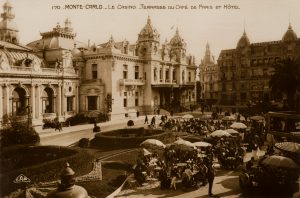
The opera house (partial view) at left, the Casino’s entrance (centre) and the Hotel de Paris (right). Patrons of the Cafe de Paris in the foreground.
When Diaghilev and his dancers eventually returned in 1922, they established Monte Carlo as their permanent base. Through to deal struck with Raoul Gunsbourg, the dancers spent six continuous months in the seaside neighbourhood, performing as the Ballets Russes, supplementing Gunsbourg’s resident opera ballet company, and staying on for annual holidays as desired.14 For Monte Carlo, it was a golden era of artistic activity, a time when Diaghilev and Picasso might be spotted talking on the steps of the Hotel de Paris, when choreographers Bronislava Nijinska and Leonid Massine busily discussed new scores with composers like Igor Stravinsky and Georges Auric. Diaghilev, encouraged by the patronage of Princess Charlotte (whose father, Prince Louis II, had recently succeeded as Monaco’s ruler), also submitted bold plans to the Casino for a Museum of Modern Art and an annual arts festival.15 The schemes were never realised, but Princess Charlotte remained among the Ballets Russes’ dedicated supporters, attending rehearsals and even taking private ballet lessons with Grigoriev’s wife.16
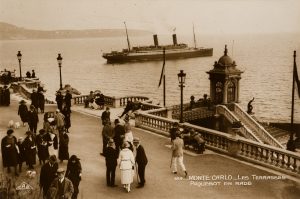
The terraces in the era of the Ballets Russes. One can easily imagine company members stopped to talk to their admirers in this view.
Those halcyon years ceased abruptly with Diaghilev’s death in 1929. His renowned company dissolved and three-year hiatus ensued before another company, the Ballets Russes de Monte Carlo, was formed, boasting fresh faces alongside former Ballets Russes members. Irina Baronova, who later settled in Australia, was just twelve years old when she became one of the company’s three adored “baby ballerinas”. For Baronova, Monte Carlo in the 30s was still magical, “a lovely place, discreetly elegant”, where the air was “filled with the aroma of mimosa and jasmine” and pastries from the Patisserie Pasquier were a dancer’s special treat.17 The Ballets Russes de Monte Carlo, through its tours and its use of the hallowed name of the original company, made “Monte Carlo” synonymous internationally with the glamour of ballet. When the company was splintered by artistic infighting (its leaders, as impresario Sol Hurok quipped, victims of “Diaghileffitis”18), “Monte Carlo” became hotly fought-over nomenclature, claimed by a succession of ballet companies that toured the globe between the 1930s and late 1950s.
Fortunately for the increasingly neglected citizens of Monaco itself, one of these companies, on an American tour, inspired a little girl in Philadelphia with a life-long love of ballet. She started lessons, dressed her dolls in tutus and pointe shoes, and briefly contemplated dance as a profession.19. Instead, Grace Kelly turned to acting, and became a Hollywood screen icon through her roles in Fred Zinnemann’s High Noon, and Alfred Hitchcock’s To Catch a Thief and Rear Window. In 1956, Kelly’s fairytale wedding to Prince Rainier III of Monaco reached global audiences through newsreels and a documentary shot by MGM Studios.20 While marriage and official duties cut short her screen career (in 1977 she reluctantly turned down a part in the cult ballet movie The Turning Point), Princess Grace of Monaco set her sights and energies on reviving Monaco as a major European centre for music, dance, theatre and the arts.21
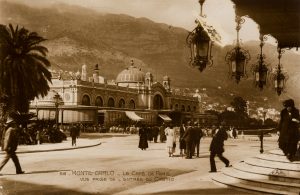
The Cafe de Paris was rebuilt an inexcusable number of times during its early life. This is my favourite incarnation (I own a weakness for Orientalist architectural fantasies). This view is from the front steps of the Casino. And those lamps! Aren’t they just the cat’s pyjamas?!
After initial plans for a new Monte Carlo ballet company foundered in the 1960s, Princess Grace sought advice from George Balanchine, and in 1975 she oversaw the founding of a ballet school, the Princess Grace Academy.22 In the wake of Grace’s sudden, tragic death in a car crash, Les Ballets de Monte-Carlo was born in 1985 under the patronage of her daughter, Princess Caroline. To begin with, the company’s directors, husband-and-wife duo Pierre Lacotte and Ghislaine Thesmar, concentrated on restaging Ballets Russes heritage works.Today, under Jean-Christophe Maillot’s directorship, the company honours its illustrious forerunners with an emphasis on innovation, after Diaghilev’s example. Much has changed in the interim – the company no longer dances at the Casino’s theatre, and the Casino, incidentally, is no longer Monaco’s primary source of revenue. However, the roulette wheels are still spinning, the Grimaldis remain proud patrons of ballet, and Les Ballets de Monte-Carlo really does belong to Monaco.
© Caitlyn Lehmann, 2019
Enjoyed the tour? Please consider making a donation to support my research and my dreamings of the Cafe de Paris!
- Arnold Haskell, Diaghileff: His Artistic and Private Life (London: Victor Gollancz, 1955), 228. ↩
- Serge Grigoriev, The Diaghilev Ballet, 1909-1929 (Harmondsworth, UK: Penguin Books, 1960), 189. ↩
- Grigoriev, 59-60 & 108. ↩
- Julian Hale, The French Riviera: A Cultural History (New York: Oxford University Press, 2009), 37-38. ↩
- Xan Fielding, The Money Spinner: Monte Carlo Casino (London: Weidenfeld and Nicolson, 1977), 18 & 34. ↩
- Fielding, 48-49, 55-58. On the background of Francois Blanc, see Fielding’s chapter on ‘The Blanc Brothers’, 36-52. ↩
- Fielding, 57 & 63. ↩
- Fielding, 21. ↩
- ‘The Drainage of the Monte Carlo’, The Lancet, 9 April 1887, 751. ↩
- Fielding, 110. The Lancet, cited above, described the opera house’s orchestra as “one of the best in Europe” (p. 750) and so too did The Era (7 February 1819), observing that “the celebrated orchestra, probably the best string band in Europe, provide{s} an exquisite treat to all lovers of high class music—free, gratis, for nothing, too.” On Gunsbourg, see Ivor Guest, The Divine Virginia (New York, NY: Marcel Dekkar, 1977), 153-54, 157. ↩
- Guest, The Divine Virginia, 153-56; ‘Opera at Monte Carlo’ in The Era, 5 March 1898. ↩
- Hale, 92. ↩
- Arnold Haskell, Diaghileff (London: Victor Gollancz, 1955), 227. ↩
- Grigoriev, 188-89; Haskell, 326. ↩
- Boris Kochno, Diaghilev and the Ballets Russes (New York, Harper and Row, 1960), 284; Richard Buckle, Diaghilev (London: Hamish Hamilton, 1984), 407. ↩
- Grigoriev, 191 & 200; Buckle, 424. ↩
- Irina Baronova, Irina: Ballet, Life and Love (Camberwell, Victoria: Viking, 2005), 74 & 147. ↩
- Sol Hurok, S. Hurok Presents: A Memoir of the Dance World (Sydney: Invincible Press, 1954), 126. ↩
- Jeffrey Robinson, Grace of Monaco (Boston, MA: Da Capo Press, 2014), 16; Donald Spoto, High Society: Grace Kelly and Hollywood (London: Random House/Arrow, 2010), 5 ↩
- https://en.wikipedia.org/wiki/The_Wedding_in_Monaco, retrieved April 11, 2021. ↩
- Spoto, 207 & 195. ↩
- http://archives.nypl.org/dan/19695, retrieved April 11, 2021; Richard Buckle, George Balanchine, Ballet Master (New York: Random House, 1988), 309; Bernard Taper, Balanchine: A Biography (Berkeley: University of California Press, 1987), 375. ↩

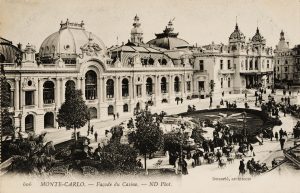
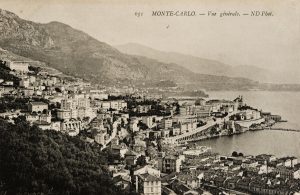
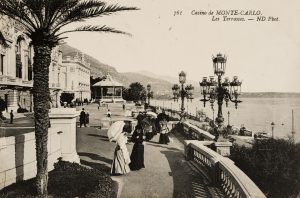
Do I recognise that terrace from “the Red Shoes”?
Ooh, now there’s a thought, Keith. Stay tuned while I fish out my DVD of the film … Oh yes, you are absolutely right! The action moves to Monte Carlo around the 45 minute mark, with Mount Agel seen behind the dancers as they exit the lift up to the Monte Carlo Railway Station. When Vicky Page steps out of the Hotel de Paris into a waiting car, you can see the Cafe de Paris in the background as the car moves off around the Place de Casino.
This website provides a location by location guide to the film: https://www.reelstreets.com/films/red-shoes-the/. Apparently the deserted mansion she visits is the Villa Leopolda, Avenue Leopold II, nearer to Nice rather than Monaco. But definitely some of the terrace scenes are shot around the Monte Carlo Opera House.